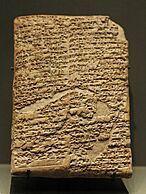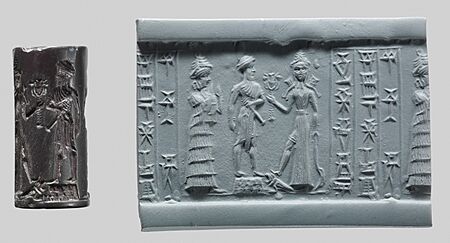Old Babylonian Empire facts for kids
Quick facts for kids
Old Babylonian Empire
|
|||||||||||
|---|---|---|---|---|---|---|---|---|---|---|---|
| c. 1894 BC – c. 1595 BC | |||||||||||
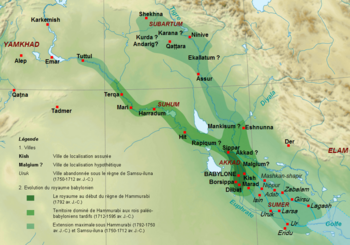
|
|||||||||||
| Capital | Babylon | ||||||||||
| Common languages | Akkadian (official), Sumerian (literary), Amorite | ||||||||||
| Religion | Babylonian religion | ||||||||||
| Government | Monarchy | ||||||||||
| King | |||||||||||
|
• c. 1894–1881 BC
|
Sumu-abum (first) | ||||||||||
|
• c. 1626–1595 BC
|
Samsu-Ditana (last) | ||||||||||
| Historical era | Bronze Age | ||||||||||
|
• Established
|
c. 1894 BC | ||||||||||
| c. 1595 BC | |||||||||||
|
• Disestablished
|
c. 1595 BC | ||||||||||
|
|||||||||||
| Today part of | Iraq Syria |
||||||||||
The Old Babylonian Empire, also called the First Babylonian Empire, existed from about 1894 BC to 1595 BC. It began after the Third Dynasty of Ur ended the power of Sumer. This period is sometimes called the Isin-Larsa period. Historians still discuss the exact dates for the first dynasty of Babylonia. There are different lists of kings, but this article uses the widely accepted dates from "Babylonian King List A."
Contents
Finding Out About the First Dynasty
It's tough for historians to learn about the start of the First Babylonian dynasty. This is because the ancient city of Babylon has very few old buildings or items left. The ground there has a high water table, which means it's often wet. This makes it hard for old materials to survive.
What we do have are written records. These include royal writings, religious texts, and lists of important events each year. There aren't many records about daily life or money matters. But the stories and year lists help us understand when things happened.
Early Kings of the Empire
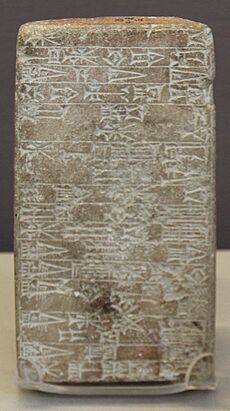
We don't know much about the first kings, from Sumuabum to Sin-muballit. We know they were Amorites, not Akkadians. They didn't make the empire much bigger.
The first known king, Sumuabum, worked to expand Babylon. He conquered nearby cities like Dilbat and Kish. His follower, Sumualailum, finished building a wall around Babylon. He also stopped rebellions and even took control of Nippur for a short time.
Kings like Sabium, Apil-Sin, and Sin-muballit kept ruling the lands. They also made the city walls stronger and started building canals. Sin-muballit is known for defeating Rim-Sin I, which kept Babylon safe. His son, Hammurabi, then became king.
King Hammurabi's Reign
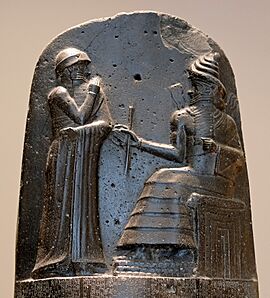
Hammurabi ruled Babylon from 1792 to 1750 BC. He is one of the most famous ancient kings. When he started, his empire was small, just a few towns near Babylon. These included Dilbat, Sippar, Kish, and Borsippa.
By 1762 BC, Hammurabi captured Eshnunna. This gave him control of important trade routes and made his empire stronger. Soon after, his armies took over Assyria and parts of the Zagros Mountains. In 1761 BC, Babylon gained control of Mari. This meant Hammurabi ruled almost all the land that was once part of the Third Dynasty of Ur.
During his 30th year as king, Hammurabi conquered Larsa from Rim-Sin I. This gave him control over rich cities like Nippur, Ur, Uruk, and Isin. Hammurabi was very important because he united Southern Mesopotamia. He made Babylon the main city of his empire, which then ruled Mesopotamia for over a thousand years.
The Code of Hammurabi
One of Hammurabi's greatest achievements is the Code of Hammurabi. This is one of the oldest written law codes in history. It's carved in cuneiform writing on a tall stone pillar, about 2.25 meters (7 feet 4½ inches) high.
At the top of the stone, there's a carving of Hammurabi receiving his power from the sun god Shamash. Below this, all the laws are written. The text explains that Hammurabi created these laws to bring justice to his land. He believed these laws were given to him by the gods.
Hammurabi wrote, "When the god Marduk commanded me to provide just ways for the people... I established truth and justice." The code then lists many laws. These laws describe fair punishments for crimes and rules for people to live by.
Insights from Mari Archives
Zimri-Lim, the king of Mari, helped modern historians a lot. His palace had many written records. These records tell us about the history and diplomacy of the First Babylonian dynasty during Hammurabi's time.
The archives from Babylon itself are lost because they are under the water table. But Zimri-Lim's palace at Mari was burned by Hammurabi. This fire actually helped preserve the clay tablets. These documents include letters about alliances between kings and military matters.
After Hammurabi: The Empire's Decline
We know less about the kings who ruled after Hammurabi. From Samsuiluna to Samsuditana, there are few records. Samsuiluna did defeat Rim-Sîn II. However, Babylon lost much of the land Hammurabi had conquered. The kings who followed faced similar problems.
The First Babylonian dynasty eventually weakened. It lost land and money. Finally, the Hittites, who were expanding from Anatolia, attacked and destroyed Babylon. After this, the Kassite Period began, lasting from 1570 to 1154 BC. The Kassites had already been in the region for a long time before Babylon fell.
The Sun and Sky in Babylonia
The sun was very important to the Old Babylonians. Shamash was their god of the sun, justice, and telling the future. As mentioned in Hammurabi's Code, Shamash was seen as guiding Hammurabi. He represented the idea that the king would bring justice to the land, just as Shamash did as a god.
Ancient Babylonians also studied the sky. They observed the sun, moon, and planets. For example, there are famous clay tablets called the Venus tablets of Ammisaduqa. These tablets record observations of the planet Venus. Such records help historians understand the timing of events in ancient Babylonia.
Ancient Babylonian Seals
Kings of the First Dynasty
Here is a list of the kings of the First Babylonian Dynasty, using the "middle chronology" dates:
| King | Reigned | Comments | |
|---|---|---|---|
| Sumu-abum or Su-abu | c. 1894–1881 BC | Lived at the same time as Ilushuma of Assyria | |
| Sumu-la-El | c. 1881–1845 BC | Lived at the same time as Erishum I of Assyria | |
| Sabium or Sabum | c. 1845–1831 BC | Son of Sumu-la-El | |
| Apil-Sin | c. 1831–1813 BC | Son of Sabium | |
| Sin-muballit | c. 1813–1792 BC | Son of Apil-Sin | |
| Hammurabi (Most important ruler) |
c. 1792–1750 BC | Son of Sin-Mubalit. Lived at the same time as Zimri-Lim of Mari, Siwe-palar-huppak of Elam and Shamshi-Adad I of Assyria. | |
| Samsu-iluna | c. 1750–1712 BC | Son of Hammurabi | |
| Abi-eshuh or Abieshu | c. 1712–1684 BC | Son of Samsu-iluna | |
| Ammi-ditana | c. 1684–1647 BC | Son of Abi-eshuh | |
| Ammi-saduqa or Ammisaduqa | c. 1647–1626 BC | Known for the Venus tablet of Ammisaduqa | |
| Samsu-Ditana | c. 1626–1595 BC | Babylon was attacked by the Hittites. |
See also
- Chronology of the Ancient Near East
- Kings of Babylon
- List of lists of ancient kings
- List of Mesopotamian dynasties
- Short chronology timeline
- Timeline of the Assyrian Empire


